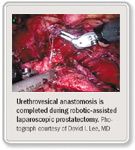Article
RALP is feasible in community practice, study shows
San Antonio--Robotic-assisted laparoscopic prostatectomy (RALP) is a minimally invasive procedure associated with a shorter operative time than that of conventional laparoscopy, and clinical outcomes comparing favorably to those obtained after open radical prostatectomy performed at major centers, according to a study presented at the AUA annual meeting here. David I. Lee, MD, who gathered the data while in private practice, said his findings suggest that the procedure can be successfully adapted to a community practice setting.

Dr. Lee learned the RALP procedure using the daVinci Surgical System (Intuitive Surgical, Sunnyvale, CA) during a laparoscopic fellowship that he completed in July 2003. From that program, he joined a large urology group practice in Arlington, TX, where he analyzed prospectively collected data from a series of 231 RALP procedures he performed as a private practitioner over a 1-year period beginning in September 2003.
The results showed that all of the operations could be completed laparoscopically without having to convert a single case to open surgery and without either transfusions or postoperative drain placement. The mean operating room time measured from the time of first trocar insertion until completion of the last skin suture was 147 minutes. The average estimated blood loss was 122 cc. Ninety-eight percent of patients were discharged within 24 hours, and the Foley catheter in all patients was removed within 7 days.

Other analyses from his series showed that operating time decreased as experience increased. Considering only the last 15 cases, the average operating room time was only 119 minutes.
"Currently, I am routinely completing all of my cases in under 2 hours," Dr. Lee said.
Improved outcomes, economies
Evaluation of positive margin and complication rates showed outcomes with the RALP procedures were on par with those reported in published open surgery series. The 231 men who underwent RALP comprised 164 men with pT2 tumors and 61 with pT3 tumors. The positive margin rates for the pT2 and pT3 tumors were 7.3% and 54%, respectively, which equated to an overall positive margin rate of 20.4%.
Continence rates also were very good. An analysis of men with at least 3 months of follow-up showed 50% needed no pads at all, while 27% used only one pad per day. Among men who were 6 months post-surgery, 80% used no pads and 10% used only one pad per day.
The overall complication rate was 9%, with only three major complications: deep vein thrombosis, rectal injury, and incarcerated inguinal hernia. There were no bladder neck contractures, reported Dr. Lee.
Because the hospital stay for the vast majority of men who have undergone RALP is less than 23 hours, Dr. Lee noted that, at his institution, RALP is precertified as an outpatient procedure. Consequently, the hospital derives a significant financial benefit from RALP cases, and that has implications for the cost controversy surrounding the procedure.
"One objection that has been raised against the RALP procedure relates to its cost, as people argue about the high cost of the robot and the other necessary equipment. However, the other side of the coin is that, because this surgery can be performed as an outpatient procedure, it is very profitable for the hospital," Dr. Lee said.
In July, Dr. Lee joined the University of Pennsylvania staff as assistant professor of surgery and chief of urology, Penn Presbyterian Hospital, Philadelphia.




